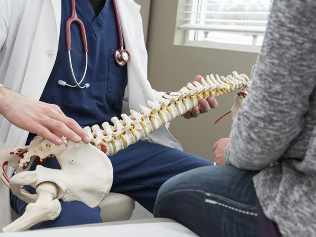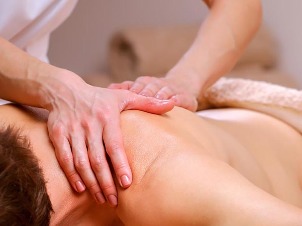In osteochondrosis of the lumbar spine, the symptoms and treatment of the disease will be discussed further, the individual has limited mobility, the ability to live a normal life. Almost all patients complain of pain in this part of the back. According to Hain's results, lumbar osteochondrosis is second after respiratory diseases.
If recently age-related degenerative processes were thought to be the main cause of pathology, now disease-causing factors have been elucidated. Before starting therapy, you need to understand that the lumbar spineWhat is Osteochondrosis?
The disease is a pathological change in the intervertebral disc, along with dystrophy of the ligaments, destruction of the vertebral bodies themselves. It is the lumbar spine that suffers most, as it experiences a tremendous weight when lifting weights in a sitting position. is.
Symptoms of osteochondrosis of the lumbar spine manifest rapidly in young people, barely 30 years old. The disease is impossible to start, as the complications are fraught with disability, paralysis of the lower extremities.
lumbar osteochondrosis main symptoms
Lumbar osteochondrosis is a degenerative pathology, which in most cases is a natural aging process. But high physical activity, metabolic disorders on the spine, misuse of harmful products and alcohol accelerate this process.
The first symptoms of pathology do not appear immediately, so therapy does not always begin on time. With osteochondrosis of the lumbar spine, the symptoms are as follows:
- Pain often occurs in the first stages and intensifies in 2-3 stages of the development of the disease (with the implementation of any sudden movements, the discomfort becomes stronger, and it goes away during bed rest. it happens);
- With osteochondrosis, sensation of weakness in the feet (tendon reflexes is lost in the lower extremities, which is clearly visible during neurological tests);
- curvature of the lumbar part;
- Violations of urination and defecation (depending on where the spinal cord was placed).

Additional symptoms of lumbar osteochondrosis can also be identified: a feeling of numbness in the lower back, dryness and peeling of the skin, a change in its shadow (it turns blue). Sweating increases. One of the symptoms of osteochondrosis in men with the lumbar spine is thought to be erectile dysfunction.
With osteochondrosis of the lumbar spine, symptoms vary in severity. Some manifestations can be combined into syndromes.
| Syndromes | attribute |
| ischemic | Here, symptoms of lumbar osteochondrosis are seen due to damage to blood vessels. Arterial cramps begin (the process becomes permanent over time). This condition causes pain in the muscles of the lower leg and thighs while walking. If the blood vessels are pinned and dilated for a long time, the nutrition of the pelvic organs is disturbed, as is their functionality. In women, the deformity causes problems with the menstrual cycle, a child. Ability to conceive, urinate |
| Vertebral | It is characterized by pain of varying intensity and localization. It arises after a load on the lumbar spine: tilt, lift heavy objects. If there is a herniated disc, the person may lose sensitivity in the legs. In this case, there are changes in the spine: there is a change in posture, the person becomes sluggish, the gait becomes problematic |
| radicular | The vertebrae become unstable, narrowing not only the nerve roots, but also the blood vessels. A symptom of a syndrome is pain at the site of pinching of the end. Unpresented sensation extends to the buttocks and legs. A person's muscles. Tones increase, they are forced to change their gait. In the absence of treatment for osteochondrosis, nerve roots become inflamed. This condition is accompanied by edema of the body tissues around the spine. Blood starts to stabilize. The process of intoxication begins. With radicular syndrome, pain is observed in other joints. In addition to these symptoms, a feeling of "creep" appears in the lower back (lower back). In difficult cases, patients can no longer move freely |
People suffering from osteochondrosis of the lumbar part of the back must undergo a thorough examination to find out how severe the disease is, and to determine therapy.

Lumbar osteochondrosis deficiency
Lumbar osteochondrosis develops slowly. Such stages of progression of pathology are:
- First of all. In this case, the nucleus pulposus, which is located inside the disc, starts moving and changing. Cracks appear on the red ring. Nervous roots become irritated, which causes back pain. Is indicated. At this stage of osteochondrosis, discomfort is still local in nature, that is, symptoms are felt only in the area of the damaged disc. Sometimes it is a lumbar, but in the earlier stages of development, often persistent. Dull pain occurs. Osteochondrosis increases discomfort after weight on the lumbar spine.
- Second. There is destruction of the fibrous ring. The mobility of the femoral vertebrae increases, while the muscle tissue becomes tense. As the distance between them decreases, they can move relative to each other. It becomes more difficult for a person to move, as he gets tired quickly, feels severe discomfort in the lumbar part. The pain spreads to the thighs, legs, buttocks. The person sweats more.
- Third. In this stage of the disease, the pain intensifies several times, as the fibrous ring bursts. In this case, the nucleus pulposus leaves its place and a hernia form. The patient feels sharp pain and lumbago. When the tissue and nerve roots are compressed. The discomfort becomes constant and unbearable. The work of internal organs is interrupted.
- Fourth. Spinal column deformity. It is very difficult for a person to move, but the pain symptom becomes less pronounced. This does not necessarily mean that pathology is no longer developing. This state is a sign. That a person will soon sit in a wheelchair. Also, in the area of the damaged disc, osteophytes proliferate, exacerbating the condition even more, muscle atrophy occurs.
If the development of the disease is not controlled and timely therapy is not initiated, the vertebrae will simply collapse and restore them without risky and difficult operation.
what to do in the event of the disease growing
Lumbar osteochondrosis is a difficult disease that should not be brought to an end stage. It becomes chronic quickly, because even the most effective treatment can only prevent or slow the development of pathology. is.
If there is severe pain in the back, and the person cannot move normally, then it indicates an exacerbation of the disease process. Mostly it occurs in patients who do not follow the recommendations of the doctors. If an exception has occurred, a person must follow these rules:
- It is better to completely abandon physical activity for the time it takes to restore the body's normal functionality. It is better to lie in a comfortable position that does not cause discomfort. It is good if the patient is on a difficult side. Uses the mattress, because in this case the body (especially the lumbar region) is not relaxed.
- To reduce the load on the back, a person may use a semi-rigid corset. This will restrict sudden movements.
- To reduce the severity of pain in osteochondrosis, you need to bend your leg slowly at the knee on the affected side. This will help relieve muscle tension and relieve pinched nerve.
- In difficult cases, the applicator may be used, but it should be used with caution. The procedure is performed twice a day for 30 minutes.
- After the massage, which will gradually restore normal blood circulation and muscle tone, you should use an anti-inflammatory ointment.

Heat the affected area after the first day's stimulation. Dry heat is applied only on the second day when the peak of pain has passed. Otherwise, tissue edema will increase, and the condition of the patient with osteochondrosis. Will be spoiled
disease diagnosis
Lumbar osteochondrosis requires a serious approach and complex therapy. It becomes easier for a patient if he or she takes the right medicines, exercises prescribed by a doctor. To choose a medical regimen, The patient should be examined. The following diagnostic methods are out:
- X-ray. If the lumbar joints are affected, evaluation by radiography is considered to be salient. The picture is taken in several projections. On that you can see damage to the disc, the spine. The position of the bone canal. Each projection must be perpendicular to the previous one.
- MRI or CT. Presented procedures help identify more precisely which factors trigger the development of osteochondrosis, in which case there are not only vertebrates, but also soft tissue, blood vessels, nerve endings. Also, the person does not feel any discomfort.
- external examination with damage to the damaged area and neurological examination.
Only a thorough diagnosis will determine if a person actually develops osteochondrosis.
treatment of lumbar osteochondrosis
If osteochondrosis of the lumbar is not treated, the patient develops complications such as protrusion, spondylarothritis, hernia, inflammation of the sciatic nerve, narrowing of the spinal cord and dysfunction of the pelvic organs. The person is also lame. He begins to have foot paralysis and paralysis.
Treatment of osteochondrosis of the lumbar spine itself determines many functions. First of all, in this disease it is necessary to eliminate the inflammation that causes pain. Naturally, you need to stop unpleasant symptoms yourself, As well as the lumbar region, the muscle corset in the lower extremities will have to be strengthened.
Therapy should relieve inflammation and soft tissue spasms. Means designed to improve the efficiency of organs, regulate blood circulation, restore metabolic processes in the body, and expand range of motionMore procedures are prescribed. Since patients with lumbar spine osteochondrosis will be treated for a long time, you have to choose the methods that will give a good effect and cause the least harm. Medicine, alternative treatments, physiotherapy, LFAnd other methods are used.
surgery
In advanced cases, when the development of the disease has reached the final stage, lumbar osteochondrosis requires surgical intervention. A surgeon's help is required in the presence of complications that affect the functionality of the limbs, a vertebral hernia. If there is a risk of developing paralysis of the lower extremities, an emergency operation is performed.
is the most effective intervention to remove a damaged disc. The microsurgical method of treating osteochondrosis of the lumbar spine using a broad endoscope is less painful for the patient and is retrieved in the shortest possible time. Allows to do.
physiotherapy procedures
With lumbar osteochondrosis, symptoms (they are treated in different ways) can be eradicated with the help of physiotherapy procedures. Use:
- diadynamic currents;
- electrophoresis and phonophoresis;
- magnetic therapy;
- laser treatment.
Physiotherapeutic procedures in combination with drugs will give maximum benefit in combination therapy.
physiotherapy practice
Treatment of lumbar osteochondrosis will not be effective without a complex demonstration of physician-prescribed exercise therapy. All exercises aim to improve mobility of the lower back, strengthen the muscle corset and increase the stability of the spine. Must be executed regularly.
The doctor usually prescribes the following exercises: bending in different directions, standing position, moving back and forth, tension in the abdominal muscles.

massage
This can only be done after expiration or during release. Thanks to the process, you can not only achieve relaxation of the spasmodic muscles, but also their strengthening. Massage after bathing is more effective. Must be performed by a specialist, applying the correct techniques: stroking, rubbing. The procedure cannot be performed. If there are open wounds on the back, a person has been diagnosed with skin diseases or problems with circulation.
manual therapy
Manual therapy solves the same tasks as massage, but uses slightly different techniques. You can't trust your spine to an amateur. The procedure requires an experienced specialist who will not harm.
medicine
In the treatment of osteochondrosis of the lumbar spine, drugs cannot be removed. When choosing them, the normal state of the body, the stage of development of the disease, matters. To combat osteochondrosis, drugsThe most effective groups are:
analgesic.
- NSAIDs- These drugs eliminate inflammation and the pain that accompanies it. They relieve inflammation, normalize body temperature.
- Muscle Relaxant - These drugs are prescribed by a doctor and are used only when NSAIDs fail. Muscle relaxants help relieve muscle spasms.
- Chondroprotectors - They keep the cartilage in good condition without allowing it to rupture. But they are effective only if this layer is not completely erased.
- Steroid anti-inflammatory drugs. They are appointed last in the most advanced cases.
- Multivitamins and B vitamins - Presented preparations help improve the functionality of NS.
- antidepressants (to restore the patient's emotional background).
- blockade with novocaine hydrocortisone. They are placed directly inside the part of the back from where the pain occurs. The obstructors are repeated, as they are capable of provoking muscle atrophy.
- Preparations for improving blood circulation and microcirculation.
topical medications - ointments - have good efficacy and minimal side effects. If the patient uses folk remedies for therapy, the drugs should continue to be taken.
prevention of osteochondrosis of the lumbar spine
Osteochondrosis of the lumbar spine can be prevented if you follow simple prevention rules:
- Avoid hypothermia and infection;
- Do not lift heavy objects;
- alternately worn bags on both shoulders;
- follow the drinking regime and eat right;
- keep body weight within normal range;
- timely treatment of congenital or acquired skeletal pathology;
- go swimming, move more, perform a complex of gymnastics for the lumbar area every day;
- to undergo regular medical examination.
Your own basic health care will help avoid complications of lumbar osteochondrosis, and there are many of them, and they are difficult to cope with.

















































